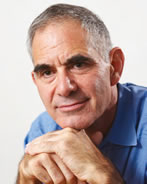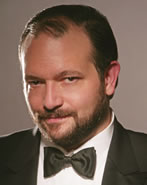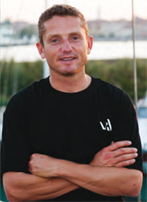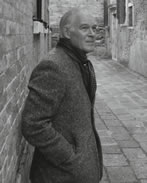PEOPLE
Mark Levinson, Producer, Audio Engineer The time has come for technology to help music. The purpose of making this collection is to raise money for the legendary opera house La Fenice, which has been making contributions to music for over 200 years. Now, due to the depressed global economy and other factors, funding from government, corporate, and private sources has almost disappeared. All the profits from The Legend of La Fenice (LLF) go to La Fenice. This is not a typical business venture; LLF represents a new model of how technology can help music.
The time has come for technology to help music. The purpose of making this collection is to raise money for the legendary opera house La Fenice, which has been making contributions to music for over 200 years. Now, due to the depressed global economy and other factors, funding from government, corporate, and private sources has almost disappeared. All the profits from The Legend of La Fenice (LLF) go to La Fenice. This is not a typical business venture; LLF represents a new model of how technology can help music.This project began in 2010 in the office of Alberto Sonino, director of development on Certosa Island. I expressed to Alberto my interest in helping make some contribution to Venetian culture, and within hours we were in the office of the director of La Fenice, discussing this very project. thanks to Alberto’s confidence and trust, the right people came together and within days an agreement was made to do this project. At that time, how little did we know about the complexities of the project we were undertaking! after more than one year, thanks to the support of patrons like you, we have made music and audio history, and created a new model for helping live music performances with the most advanced audio technology.
In the last 50 years, La Fenice’s archive department has cared for principally analog tape recordings of musical events that transpired at La Fenice. these recordings suffer from severe sonic limitations that make them have virtually no commercial value. using the most sophisticated mastering technology and the human ear and heart, a considerable large amount of tapes were evaluated, a selection made, and painstakingly processed. The result is that for the first time since the live performance, people have the opportunity to glimpse the magnificent music that was played at La Fenice - opera, symphonic, solo piano, and jazz - during a bygone era of which these are the only soundtracks remaining. To hear these artists with this fidelity, albeit not always perfect, is a first in the history of recorded music. The fact that all the profits go to La Fenice is the soul of the project. Everyone involved has been driven by the motivation to help La Fenice and show gratitude for what it has given to the world for three centuries.
Important contributions have been made by a number of people who share this feeling. For me, the real hero of this project is José Andrade. José is a professional opera singer, a man of unshakable values, keen intelligence, understanding of music, a pure heart and the commitment to do whatever was necessary to find the jewels in the archives and create the collection. No one spent as many hours building this collection, piece by piece, as José . My contributions were principally in developing the concept, personally doing the remastering, and helping to arrange the marketing and sales channels that would result in a successful conclusion to the project. I invested in making a small studio on Certosa Island where we could work in peace and quiet with a Daniel Hertz M1 reference system, and meet with the right people to do the LLF project to the highest professional standard. Again, thanks to Alberto Sonino for his personal interest, encouragement and support throughout.
The book was envisioned towards the end of the project when it became clear that La Fenice’s archives held a vast and priceless collection of written materials, posters, and photographs that brought dimension and life to the music in the collection. The book also shows the enormous importance of La Fenice’s archives, as the holder of irreplaceable treasures. Catherine Perman, herself a professional opera singer, undertook the creation of the LLF book with great care. We are blessed to have for the front cover of the book a painting by Robert Morgan, an american painter residing in venice, which transmits straight to the heart the essence of La Fenice, the project, and the soul of Venice itself.
Certosa, October 2011
José Andrade, Producer, Editor-in-Chief
 Venice is a unique city: its streets are mostly water, filled with spectacular palaces and treasures from centuries long ago, the easy-going Venetian attitude, all contributing to make venice a thriving city. One of its greatest treasures is la Fenice, venice’s opera and concert house, ranking as one of the leading opera houses in the world. With its gilded auditorium and exquisite artwork and carvings, it is also one of the most beautiful opera houses in the world.
Venice is a unique city: its streets are mostly water, filled with spectacular palaces and treasures from centuries long ago, the easy-going Venetian attitude, all contributing to make venice a thriving city. One of its greatest treasures is la Fenice, venice’s opera and concert house, ranking as one of the leading opera houses in the world. With its gilded auditorium and exquisite artwork and carvings, it is also one of the most beautiful opera houses in the world.I recently had the privilege of exploring one of la Fenice’s other treasures, their analogue tape collection of their performances from the mid-1960’s to 1990, true gems in the annals of recorded music. Thoroughly investigating over 2100 tapes of 1500+ performances, we are proud to present to you 22 famous performances from this time period, The Legend of La Fenice. these recordings present many of the greatest opera, classical music and jazz performers of the 20th century, as well as display the considerable talents of la Fenice’s orchestra, chorus, and ensemble members.
With mark levinson’s audio remastering techniques, we can actually feel the music performed: Renata Scotto’s heart-breaking laments in La Straniera, Ruggero Raimondi’s suave Don Giovanni, or Arthur Rubinstein’s hypnotic command of the piano, are just some of the legendary moments in this collection. The sound quality achieved by Mark far surpasses the original recordings; even the few recordings with considerable sonic limitations (distortion, tape noise, oxidation, etc.) are remarkably better than the original. Mark is a true artist, using technology as his brush, bringing dimension, warmth and color back to La Fenice’s original recordings.
None of these performances would have been possible without the generous work of executives and staff of la Fenice: Cristiano Chiarot, Simonetta Bonato, Franco Rossi, Allesandro Ballarin, Stefano Faggian and Tullio Tombolani made my work at la Fenice both productive and fun, and are as much part of The Legend of La Fenice as the performers.
Many people have assisted with this project, but Catherine Perman and Robert Morgan deserve special mention. Robert Morgan’s beautiful original painting, La Fenice, Water Entrance, reminds me that great art inspires great art. Catherine Perman (who is also my very vivacious and supportive wife) transformed the idea of this companion book, fusing all the materials from italy, switzerland, and the united states, into a worthy visual companion to the aural beauty within this collection. Her imagination and zest for the task has crafted a truly grand addition to The Legend of La Fenice.
We look forward to presenting to you many more great performances from la Fenice, both past and present; may you enjoy The Legend of La Fenice as much as Catherine, Mark, and myself have had producing it for you.
New York City, October 2011
www.jose-andrade.com
Cristiano Chiarot, General Manager - La Fenice Theatre
The history of the La Fenice Theatre in Venice has always been marked by a particular attention to the new, so it is not surprising that the repertoire of the Theatre is so full of premieres and performances designed, conceived and composed especially for La Fenice. We cannot forget the most important XIX century composers and their operas such as Vincenzo Bellini (Beatrice di Tenda and I Capuleti e Montecchi), Gaetano Donizetti (Pia de’ Tolomei, Maria di Rudenz and Belisario), Gioachino Rossini (Tancredi, Semiramide and Sigismondo) and Giuseppe Verdi (Ernani, Attila, Rigoletto, La Traviata and Simon Boccanegra).
The attention to new creations continued in the last century with Igor Stravinsky, who was so fond of La Fenice and the city of Venice that he asked that his remains rest in the quiet island in the lagoon of S. Michele, and with Benjamin Britten, who with his “Turn of the Screw” led the ghosts from Henry James’ Gothic novel to walk the stage of La Fenice.
The flexibility of the Theatre has enabled the Fondazione La Fenice Theatre to present all styles of music: from contemporary music to jazz, many memorable musicians have performed at La Fenice.
The importance given to the acoustics ever since its construction in 1792, allowed the La Fenice Theatre to become one of the most important theaters in the world. This status was not lost even after the terrible fire of 1996, which destroyed it completely.
The will, stubbornness, and the deep love for our Theatre, demonstrated by all national and international institutions, have made possible the reconstruction of this jewel, which is part of our precious heritage and of humanity.
Especially in the last twenty years the Fondazione Teatro La Fenice has sought to preserve and protect its rich archival heritage consisting of posters and playbills, photographs, original opera librettos, original letters and manuscripts, sketches, set design models and scores.
This recovery has extended also to the valuable audio material in our possession, which the La Fenice Theatre has produced with careful foresight since the 1960’s, when technology was still in its infancy.
One cannot hide the fact that to preserve this material and make it available, a careful historical, musicological and philological restoration is necessary, as well as a large financial commitment. This is why when Mark Levinson proposed to help our foundation by providing his knowledge and expertise in sound and acoustics to recover some of our significant titles from our archives, we launched into this exciting adventure knowing it would be the right way to preserve part of our historic heritage.
I understood right away the first time I met Mark Levinson in Venice, at the theater, about a year ago, that he was a lover of music and art. His collaboration with La Fenice can only bring good luck to our project, The Legend of La Fenice. We wish great joy to those supporters who will want to bring with them the purity of sound of the most beautiful bel canto voices, accompanied by the Orchestra and Chorus of La Fenice, directed by the most famous conductors . In so doing, they will help with the important international activity of our Theatre.
Venice, September 2011
Alberto Sonino, Director of Vento di Venezia
 Alberto Sonino is Director of Vento di Venezia, the public-private partnership for the development of Certosa, a small island on the western side of Venice. Voted “Venetian of the Year 2010,” and a champion racing sailor, Alberto Sonino is a visionary who is transforming Certosa into a park for the Venetian people and tourists who come to enjoy the tranquility, nature, new marina and yachting services, small hotel as well as the artisanal boat building on the island.
Alberto Sonino is Director of Vento di Venezia, the public-private partnership for the development of Certosa, a small island on the western side of Venice. Voted “Venetian of the Year 2010,” and a champion racing sailor, Alberto Sonino is a visionary who is transforming Certosa into a park for the Venetian people and tourists who come to enjoy the tranquility, nature, new marina and yachting services, small hotel as well as the artisanal boat building on the island.- Mark Levinson
La Fenice Theatre, designed by Giannantonio Selva, was inaugurated on May 16, 1792, only five years before the fall of the Venetian Republic. With its power waning, Venice defended its role as capital of culture by constructing the theatre.
The name of its theatre “La Fenice” (the phoenix) indicates Venice’s will to enable a future vision, to be reborn after defeat. And La Fenice has fallen and raised itself many times. In December 1836 a large-scale fire destroyed most of the theatre. A year later, having completed the reconstruction project under the direction of the Meduna brothers, the theatre was inaugurated. La Fenice closed its doors in 1859, as a statement against the Austrian occupation. It reopened in 1866 to celebrate the entry into a united Italy. In January 1996 a new, powerful fire destroyed much of the theatre, which was ambitiously rebuilt “as it was and where it was” (confronting the inevitable and legitimate arguments of those who wanted to build a new more modern theatre). It was reopened in December 2003.
I wanted to recall here, in a nutshell, the history of La Fenice because it really is emblematic of the history of Venice, its crises and will for rebirth and glory. La Fenice, along with the Biennale and the other great cultural institutions, illustrates the capacity of Venice to be a protagonist in the international cultural scene.
To counterbalance its tourism activity, Venice should leverage its enormous cultural and environmental heritage: monuments, nature, history, traditions and experiences. Culture, research, training, and activities related to the lagoon and the sea tradition, are the basis for the social and economic development of the city.
For this reason I left sailing, which had been my focus for so many years, so I could fully engage in the restoration project of Certosa, an abandoned island until a few years ago, which is separated by a few meters from the island of Sant’Elena. I like to think, with caveats, of Certosa as a phoenix: a convent, then a military settlement, devastated by deterioration and abandonment, and now returned to the community as an urban park. An island that is reborn and can be an emblem of a city that is building its future. Today in Certosa one finds mooring and facilities for boats, a shipyard for boat construction and maintenance, sailing and seamanship courses, environmental education, a Masters program in ship design, a hotel and a restaurant serving sustainable tourism, and a large park in the making.
It was at Certosa that I met Mark Levinson. He arrived a couple of years ago, by chance. He moored his boat and decided to stop here. He transformed a small space into a recording lab with a sound system designed by him, and put himself at the service of the city.
Mark had told me of his willingness to support La Fenice. Thanks to the willingness and enthusiasm of Mara Rumiz, I put him in touch with the municipal administration and the leaders of the theatre. Thus was born the restoration and mastering project of the archives, which today brings us the recording of the best performances from the past in a box set that is now being offered as a concrete support to La Fenice Theatre and the City, at yet another difficult time. I am proud to contribute to this endeavor, which I hope will be considered exemplary and may encourage other initiatives of collaboration and support.
Venice has always been an open city, a place of dialogue between different cultures, but now that the number of its inhabitants has decreased alarmingly, it really needs to attract new energy, new citizens. We are proud that Mark Levinson is one of them and that he has realized, in such a short time, this dream just as he had promised a few months ago.
Certosa, October 2011
Robert Morgan, Painter
 Venice’s diadem is adorned with many jewels. Not the least splendid of these is the legendary opera house, La Fenice. Legendary by virtue of the historic performances and performers that have graced its stage. In my own lifetime I was privileged to see “live and close up” Rudolf Nureyev, Arthur Rubinstein, Sviatoslav Richter, Alfred Brendel, Radu Lupu, Rudolf Buchbinder, Giuseppe Sinopoli, Jeffrey Tate, Luciano Pavarotti, Katia Ricciarelli, Samuel Ramey, and countless others. Memories of these moments still thrill me.
Venice’s diadem is adorned with many jewels. Not the least splendid of these is the legendary opera house, La Fenice. Legendary by virtue of the historic performances and performers that have graced its stage. In my own lifetime I was privileged to see “live and close up” Rudolf Nureyev, Arthur Rubinstein, Sviatoslav Richter, Alfred Brendel, Radu Lupu, Rudolf Buchbinder, Giuseppe Sinopoli, Jeffrey Tate, Luciano Pavarotti, Katia Ricciarelli, Samuel Ramey, and countless others. Memories of these moments still thrill me.I moved to Venice from New York in 1973 to paint. In those days it was truly a world-class international cultural capital. For a New Yorker, La Fenice was incredibly accessible in all senses. I felt as if I were cheating: a fifteen-minute walk, bargain prices, superstars. In 1996 a criminal act of vandalism and successive bureaucratic bungling darkened the theater for a decade. Those ten long years, coinciding as they did with an exponential increase in massive acultural tourism, dimmed the lights of the city for me.
La Fenice has once again risen from the ashes and is struggling to regain its former luster. The magnificent golden tone cannot be duplicated, but thanks to the efforts of Mark Levinson and José Andrade, it has been preserved for posterity. Bravo!
As a postscript, I am grateful that my little daughter, Félicité, and her generation shall share the memories.
Venice, October, 2011
Franco Rossi, Scientific Administrator of the Historical Archives, La Fenice Theatre
In 1792, a partnership of Venetian noblemen (the Nobile Società Proprietaria) created a new grand theatre for the Venetian nobility: after the theatrical splendors of the seventeenth and eighteenth centuries, the century ended with the last great theatre, the one destined to become - throughout the nineteenth and twentieth centuries - the theatre of Rossini, Bellini, Donizetti, Verdi, Wagner, Stravinsky and Prokofiev. Perhaps even the most optimistic among the founding members would not have predicted a success so great, the birth of a true legend, the embodiment of the symbol of the phoenix, the mythical bird described by the Greek historian Herodotus, which is always reborn from its ashes, as would happen in 1836 with the first fire, and with the even more dramatic one in December, 1996.
Because the theatre was not the result of the personal will of a family, but of the choice of a free association, the theatre prioritized the preservation of all its documents since its inception. The theatre still possesses the first testimonials of its construction as well as a detailed description of the administration, accounting, architecture and art of the theatre itself. With the slow passage of time the documentation that makes our archive unique expanded. The whole nineteenth century can be revisited through the autographs of Rossini, Verdi’s letters, the first, precious copies of the scores of Bellini and Donizetti, even those that were put aside by La Fenice. The theatrical posters illustrating the evening’s operas and ballets are duly preserved (and exceed twenty thousand units...). They allow us to relive the soirees from one or two centuries ago with passion and admiration. We almost feel like we are sitting next to the aristocratic owners of the theatre, listening to the voices of the early interpreters of Verdi, of the first Ernani, Alfredo, Violetta, Gilda, Rigoletto... . We can almost visualize the evolution of the dancers that accompany the operatic works, from their use of the pantomime style to the new and fascinating technique on toes, introduced by the French dancers. We view the development of Fanny Cerrito that so inflamed the hearts of Venetian patriots at the dawn of the revolutionary movements of 1848, which were subsequently recounted by Luchino Visconti in “Senso”, one of his greatest masterpieces that begins with some shots of La Fenice.
But times change, and the twentieth century bursts onto the scene full of innovations: on the one hand, we are witnessing the birth of the new musical masterpieces by Stravinsky, Britten, Prokofiev and the Venetians Maderna and Nono, thanks in part to the collaboration with the International Festival of Contemporary Music. The “new” enters forcefully in the ballet as well: in the 1980’s a month-long festival brings to Venice the most important and creative dancers and choreographers, who perform not only in the theatre but also in St. Mark’s Square and even along the Grand Canal, one of the most beautiful waterways in the world… .
The theatre also has learned to deal with the emergence of new technologies: the development of computers and networks has pushed La Fenice to create a website that now includes its entire history, from its origins to the present, allowing for exhaustive research of all facets of the theatre. To complement this imposing documentation, there are over one hundred thousand images illustrating the history of La Fenice, from the first posters (1825), to the photographs. All this material accompanies the history of the institution. The video and audio recordings were captured initially with the available technology of the time and on a trial basis, but subsequently were collected with the same continuity and determination that had marked the birth and history of La Fenice. These recordings now join the printed material. It is from this immense recorded wealth, as great and continuous as that of the printed material, that the first wonderful titles are drawn for The Legend of La Fenice, a tiara of pearls for the queen of all theatres.
Venice, September 2011